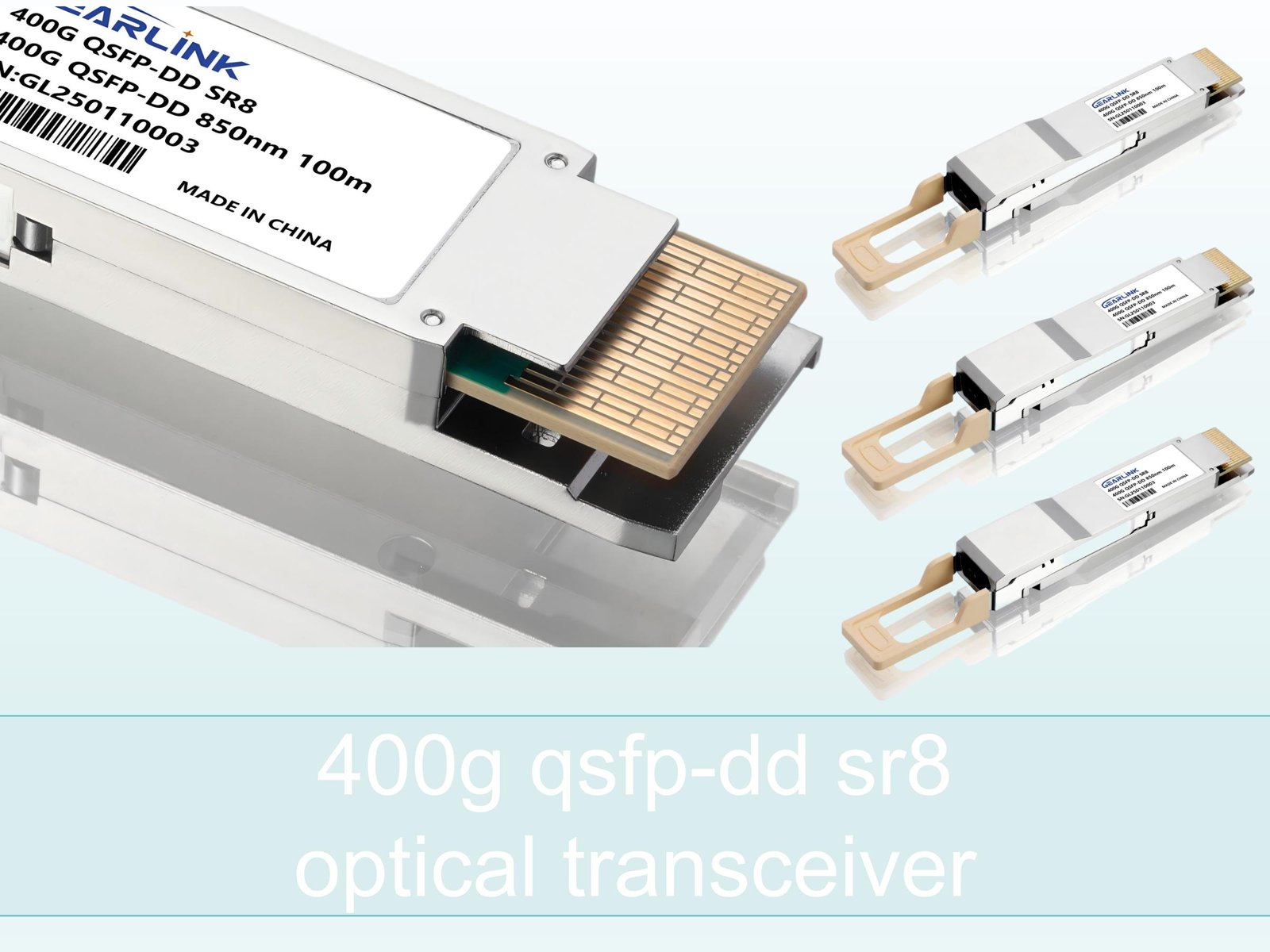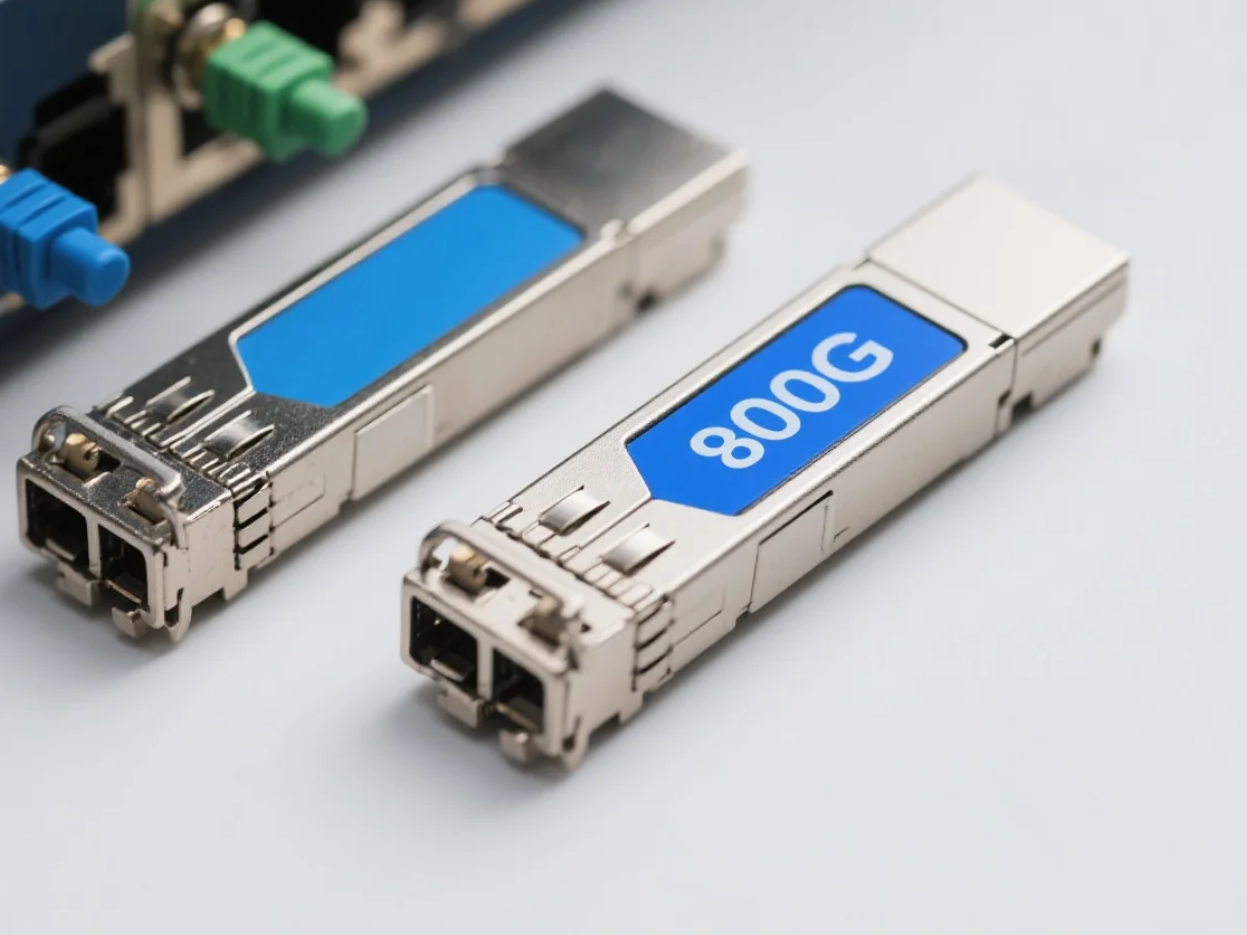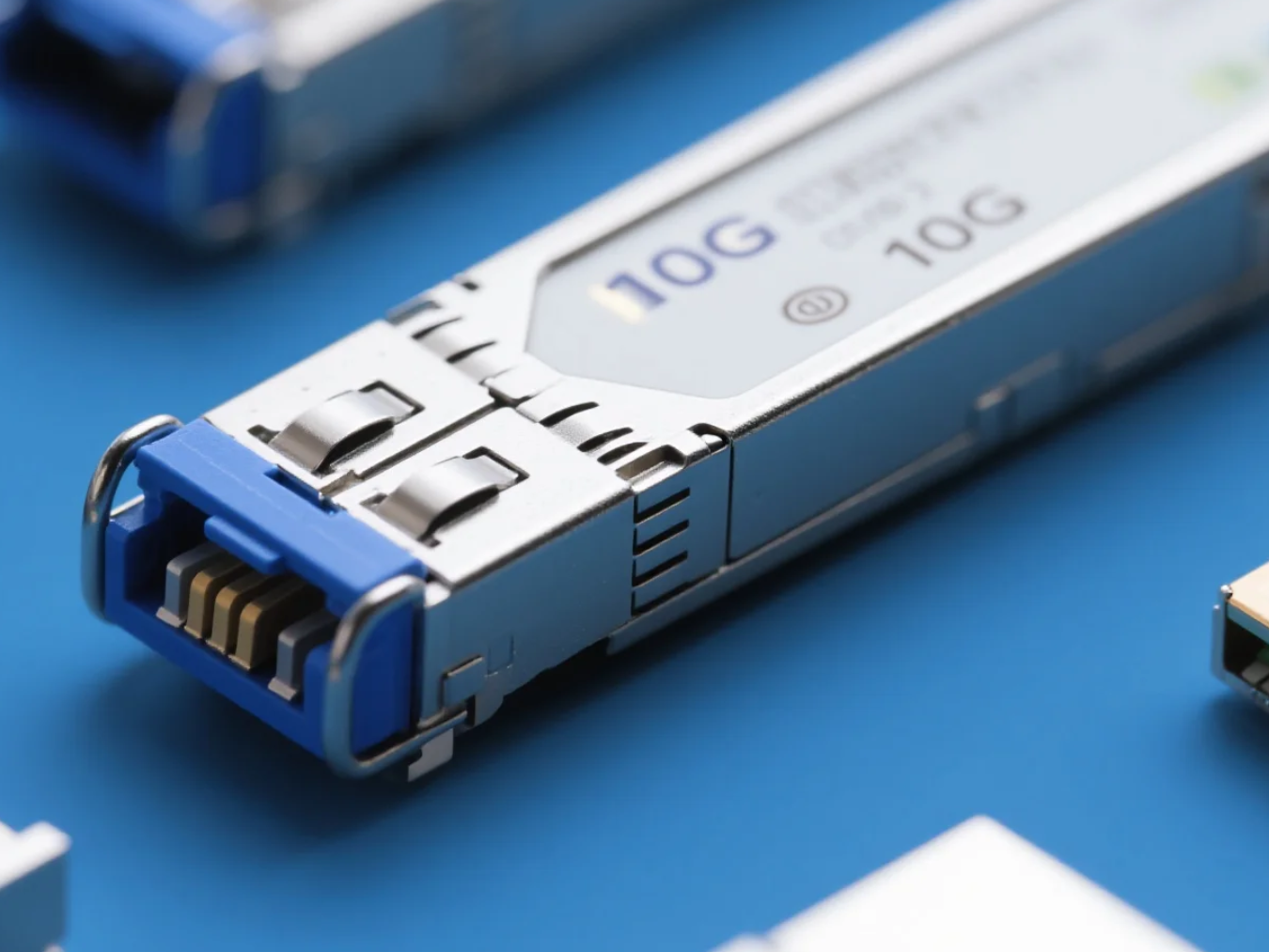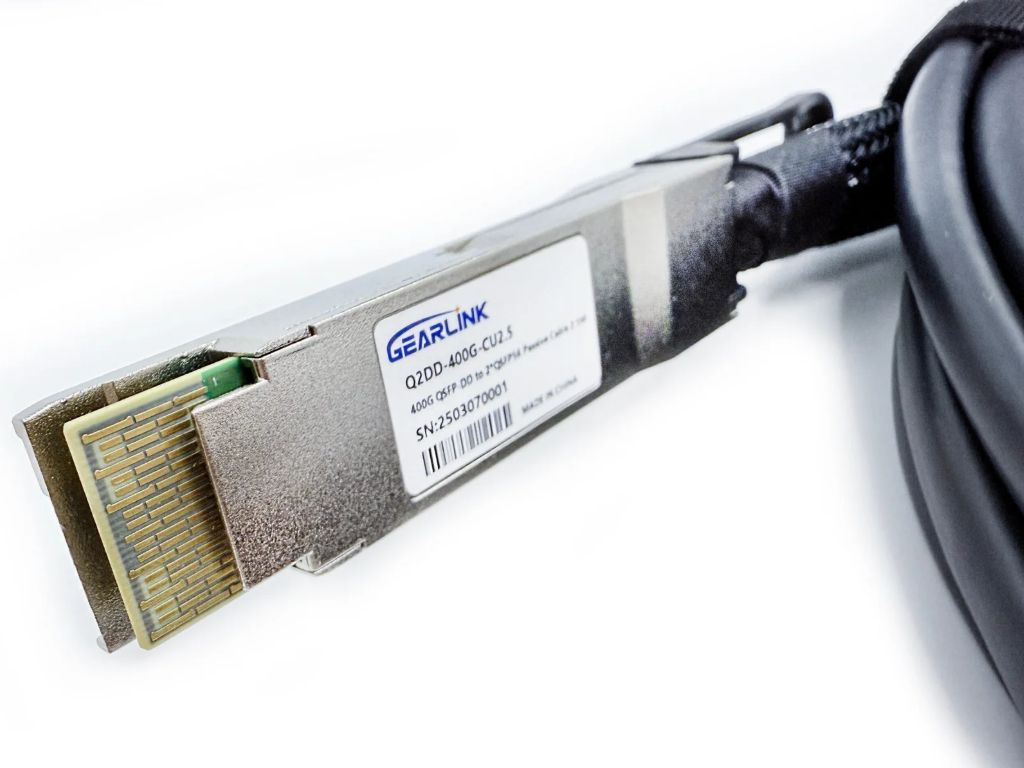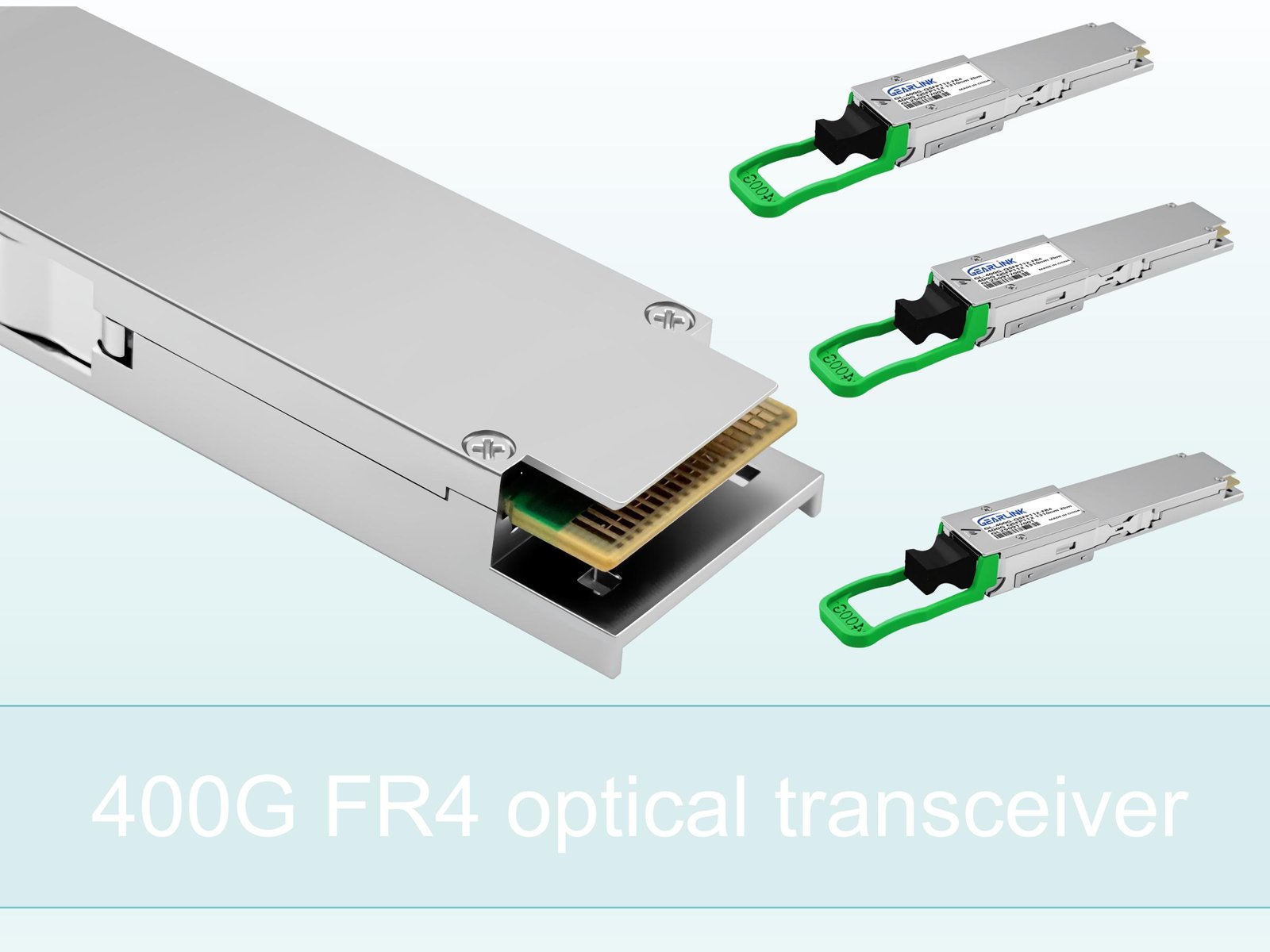Introduction to 400G QSFP-DD SR8 Technology
The evolution of data centers toward higher speeds and greater bandwidth has reached a significant milestone with the advent of 400G optical modules. Among these advancements, the 400G QSFP-DD SR8 optical module stands out as a pivotal solution for short-reach data center interconnects. This technology represents a leap forward in network infrastructure, enabling the high-speed data transmission required by modern applications such as cloud computing, artificial intelligence, and big data analytics.
The 400GBASE-SR8 standard specifically addresses the need for cost-effective, high-density 400G connections within data center environments. As network operators migrate from 100G to 400G infrastructure, understanding the capabilities and implementation considerations of these optical modules becomes increasingly important. The QDD-400G-SR8 and QDD-400G-SR8-S variants offer compatible solutions for different switch platforms while maintaining the same fundamental technical specifications.
In this comprehensive guide, we will explore the technical specifications, applications, and benefits of 400G SR8 technology, providing network architects and data center operators with the knowledge needed to successfully implement these solutions in their environments.
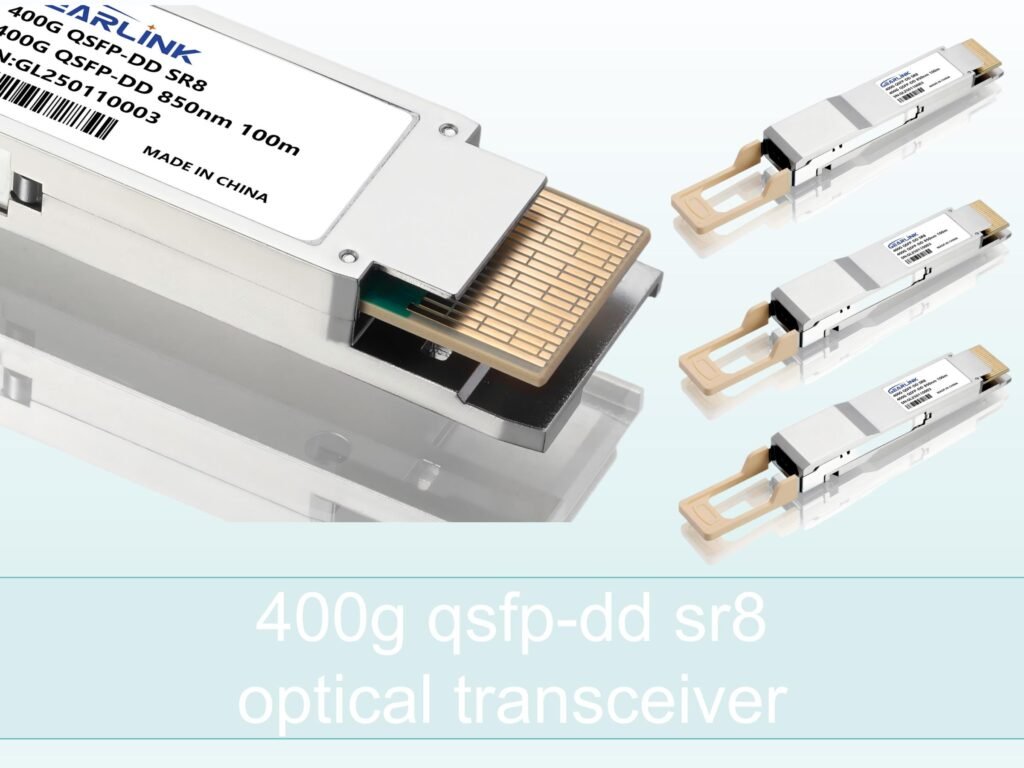
Technical Specifications of 400G QSFP-DD SR8
Physical and Optical Characteristics
The 400G QSFP-DD SR8 optical module employs a sophisticated design that integrates multiple advanced technologies to achieve its high performance. Understanding these specifications is crucial for proper implementation and compatibility with existing infrastructure.
The module utilizes 850nm VCSEL (Vertical-Cavity Surface-Emitting Laser) technology and PIN receiver technology . This combination provides an optimal balance of performance and cost-effectiveness for short-reach applications. The QSFP-DD SR8 supports a maximum transmission distance of 70 meters on OM3 fiber and 100 meters on OM4 fiber , making it suitable for intra-rack and inter-rack connections within data centers.
The module features an MPO/MTP-16 connector (typically with APC polishing) , which accommodates the eight parallel transmit and eight parallel receive channels required for 400G operation. This connector interface ensures reliable connectivity while supporting the high-density requirements of modern data center switches.
Electrical and Performance Specifications
From an electrical perspective, the 400G SR8 module employs 8x50G PAM4 modulation , which is a key enabling technology for achieving 400G speeds within the power and space constraints of the QSFP-DD form factor. PAM4 (Pulse Amplitude Modulation with 4 levels) allows each channel to carry two bits per symbol, effectively doubling the data rate compared to traditional NRZ modulation.
The typical power consumption of a 400G QSFP-DD SR8 module is ≤10W , which is remarkably efficient considering the high data rate. This efficiency contributes to better thermal management and lower operating costs in high-density deployments.
The module operates within a commercial temperature range of 0~70°C , ensuring reliable performance in standard data center environments. Additionally, it includes Digital Diagnostic Monitoring (DDM/DOM) capabilities , allowing network operators to monitor real-time parameters such as temperature, voltage, transmit power, and receive power for proactive maintenance and troubleshooting.
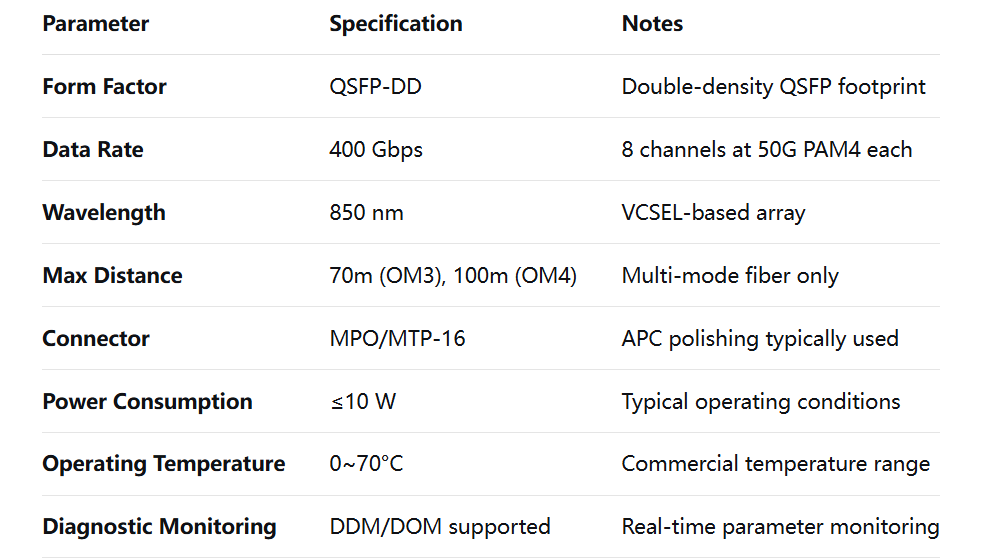
Key Features and Advantages of 400G SR8 Technology
High-Density Design and Compatibility
The QSFP-DD form factor represents a significant advancement in pluggable optical module design. By building upon the existing QSFP footprint while adding an additional row of contacts, the QSFP-DD SR8 maintains backward compatibility with QSFP28 and QSFP+ ports through appropriate adapters . This compatibility protects existing infrastructure investments while enabling seamless migration paths to higher speeds.
The high-density nature of the 400G QSFP-DD SR8 allows switch manufacturers to offer up to 36x400G ports in a 1U panel , maximizing port density and reducing the physical footprint required for 400G deployment. This density is crucial for large-scale data centers where rack space is at a premium.
Advanced Modulation and Signal Integrity
The implementation of PAM4 modulation in the 400GBASE-SR8 represents a fundamental shift from the traditional NRZ modulation used in lower-speed optical modules. PAM4’s ability to transmit two bits per symbol effectively doubles the bandwidth efficiency of each lane , which is essential for achieving 400G rates without increasing the number of fibers or lane rates beyond practical limits.
To maintain signal integrity over the eight parallel channels, the 400G SR8 incorporates DSP (Digital Signal Processing) technology , which compensates for various signal impairments and ensures robust data transmission. The inclusion of Transmit and Receive CDR (Clock and Data Recovery) further enhances signal integrity by retiming the data signals, reducing jitter, and improving the overall bit error rate performance.
Thermal Efficiency and Power Management
Thermal management represents a significant challenge in high-speed optical modules. The 400G QSFP-DD SR8 addresses this challenge through advanced COB (Chip-on-Board) packaging technology , which improves thermal conduction from the active components to the module housing. Efficient thermal design ensures reliable operation over the module’s entire temperature range without requiring excessive airflow or cooling resources.
The power efficiency of the QDD-400G-SR8 module, typically consuming ≤10W , contributes to lower operational costs and enables higher port densities without exceeding power budgets. This efficiency is achieved through advanced circuit design, power-efficient DSP implementations, and optimized laser driver technologies.
Applications and Deployment Scenarios for 400G QSFP-DD SR8
Data Center Spine-Leaf Architectures
In modern data center networks employing spine-leaf architectures, the 400G QSFP-DD SR8 plays a critical role in establishing high-speed connections between leaf and spine switches . The 100-meter reach capability of the 400GBASE-SR8 is sufficient for most data center applications, covering intra-rack, inter-rack, and even inter-row connections within the same data hall.
The high bandwidth provided by 400G SR8 connections enables seamless support for resource-intensive applications and east-west traffic patterns characteristic of cloud-native and microservices-based architectures. As server connectivity progresses from 25G/50G to 100G, the 400G uplinks provided by SR8 technology ensure that aggregation points remain non-blocking and efficient.
Breakout Applications and Migration Strategies
One of the most valuable features of the 400G QSFP-DD SR8 is its support for breakout connectivity , which enables flexible migration paths from lower-speed infrastructures. The breakout capability allows a single 400G SR8 port to connect to multiple lower-speed devices:
– 1x400G to 2x200G: Using an MPO-16 to 2xMPO-8 breakout cable, a QDD-400G-SR8-S port can connect to two 200G QSFP56 SR4 ports .
– 1x400G to 8x50G: Using an MPO-16 to 8xLC duplex breakout cable, a 400G QSFP-DD SR8 port can connect to eight 50G SFP56 SR ports .
This flexibility allows network operators to strategically deploy 400G-capable switches while gradually migrating server connections from lower speeds, optimizing capital expenditure while preparing the infrastructure for future needs.
High-Performance Computing and AI Workloads
Artificial intelligence, machine learning, and high-performance computing applications generate massive amounts of data that must be exchanged between computing nodes with minimal latency. The 400G SR8 technology addresses these requirements by providing high-bandwidth, low-latency interconnects for GPU clusters and computing arrays.
In these environments, the parallel nature of the QSFP-DD SR8 architecture aligns well with the parallel computation patterns of AI workloads. The short-reach characteristics match typical cluster configurations where computing nodes are located in close proximity within the same data center room or rack row.
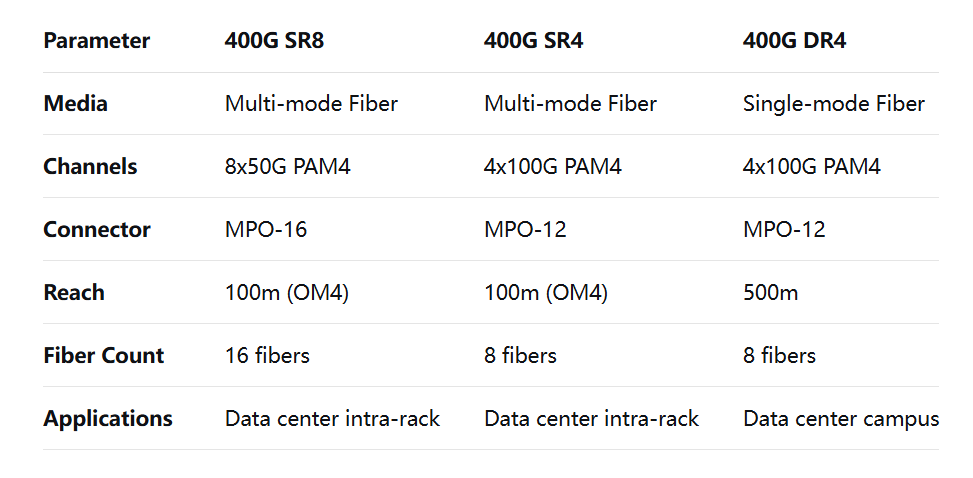
Implementation Considerations for 400G Base SR8 Networks
Fiber Infrastructure Requirements
Deploying 400G QSFP-DD SR8 technology requires careful consideration of the existing fiber infrastructure. The MPO-16 connector interface necessitates 16-fiber MPO cabling , which may represent a change from the 12-fiber or 24-fiber MPO systems commonly deployed for 40G/100G applications.
For new installations, OM4 multi-mode fiber is recommended to maximize the reach capability of 400GBASE-SR8 links . OM5 wideband multimode fiber (WBMMF) can also be used and may provide additional flexibility for future applications, though it doesn’t extend the reach beyond what OM4 supports for SR8 technology.
Proper polarity management is essential when deploying MPO-16 based systems. Network designers should implement method B (straight-through) or method C (pair flip) polarity schemes consistently throughout the infrastructure to ensure reliable connectivity without requiring special patch cords or cassettes.
Compatibility and Interoperability Testing
While standards ensure basic interoperability, practical deployment of 400G SR8 technology requires thorough compatibility testing between optical modules and networking equipment. The QDD-400G-SR8-S variant, for example, is specifically designed for compatibility with Cisco switching platforms , while the QDD-400G-SR8 targets Arista networks .
When sourcing modules from third-party manufacturers, verification of compatibility with specific switch models and firmware versions is recommended. Reputable suppliers typically provide comprehensive compatibility matrices and perform pre-shipment testing to ensure proper operation with target equipment.
Thermal Management and Power Considerations
The power consumption of ≤10W per 400G QSFP-DD SR8 module necessitates careful thermal planning, especially in high-density configurations. Switch manufacturers typically specify maximum module counts based on thermal models that assume specific airflow and ambient temperature conditions.
Network operators should adhere to these guidelines and implement adequate cooling strategies to maintain module temperatures within the specified operating range. Monitoring module temperatures via DDM/DOM interfaces allows proactive management of thermal conditions and can help prevent thermal throttling or link failures during peak utilization periods.
Future Trends and Development of 400G SR8 Technology
Evolution towards 800G and 1.6T
The underlying technology of 400G QSFP-DD SR8 serves as a foundation for next-generation speeds. The same fundamental approach of parallel optics and PAM4 modulation is being extended to achieve 800G SR8 using 100G PAM4 per channel, maintaining the same form factor and fiber count while doubling the data rate.
Looking further ahead, the industry is developing 1.6T solutions that may build upon the SR8 architecture by further increasing lane speeds or channel counts. The QSFP-DD form factor’s support for 8 lanes of electrical interface provides a natural migration path to these higher speeds while maintaining mechanical compatibility.
Co-Packaged Optics and Alternative Form Factors
While pluggable optics including the 400G SR8 will remain dominant in the foreseeable future, the industry is exploring co-packaged optics (CPO) as a long-term solution for highest density and power efficiency. In CPO architectures, the optical engine is integrated directly with the switching silicon rather than being implemented as a pluggable module.
For applications requiring distances beyond 100 meters but within the data center campus, 400G DR4 and FR4 technologies offer single-mode fiber alternatives . These solutions provide extended reach while maintaining the QSFP-DD form factor, though at higher cost due to the single-mode lasers and more complex optical components.
Market Adoption and Cost Trends
As with previous generations of optical networking technology, the cost of 400G QSFP-DD SR8 modules is expected to decline as adoption increases and manufacturing volumes grow. The relatively simpler architecture of multi-mode optics compared to single-mode alternatives positions 400G SR8 as a cost-effective solution for short-reach applications throughout the anticipated lifespan of 400G technology.
Market adoption is accelerating as major cloud providers and enterprises refresh their network infrastructures to support increasing bandwidth demands. The flexibility provided by breakout capabilities further enhances the value proposition of 400G SR8 technology, enabling graceful migration from existing 100G and 200G infrastructures.
Conclusion
The 400G QSFP-DD SR8 optical module represents a significant advancement in data center connectivity, offering high bandwidth, power efficiency, and deployment flexibility for modern network environments. With its standardized implementation, comprehensive management capabilities, and support for various connectivity scenarios, the 400GBASE-SR8 technology is poised to become the dominant solution for short-reach 400G applications.
As data centers continue to evolve to support emerging technologies and increasing bandwidth demands, the understanding and proper implementation of 400G SR8 technology will be essential for network architects and operators. By leveraging the technical details, application guidelines, and implementation considerations presented in this guide, organizations can successfully deploy QDD-400G-SR8 and QDD-400G-SR8-S solutions to build robust, high-performance network infrastructures ready for the challenges of tomorrow.
FAQs
1. What is the maximum transmission distance of 400G QSFP-DD SR8?
The 400G QSFP-DD SR8 supports transmission distances of up to 70 meters on OM3 multimode fiber and 100 meters on OM4 multimode fiber . This makes it ideal for data center intra-rack and inter-rack connections.
2. How does 400G SR8 differ from other 400G optical modules?
The 400G SR8 utilizes 8 parallel fibers with 50G PAM4 modulation per channel , while other variants like DR4 and FR4 use 4 channels with 100G PAM4 over single-mode fiber for longer distances . SR8 is specifically optimized for short-reach multi-mode fiber applications.
3. Can 400G QSFP-DD SR8 modules be used for breakout applications?
Yes, the 400G QSFP-DD SR8 supports breakout configurations to connect to multiple lower-speed devices. It can be split into 2x200G using MPO-16 to 2xMPO-8 cables or 8x50G using MPO-16 to 8xLC duplex breakout cables .
4. What type of connector does the 400G SR8 module use?
The 400G SR8 optical module uses an MPO/MTP-16 connector , which accommodates the 8 transmit and 8 receive channels required for 400G operation over parallel multimode fiber.
5. Are 400G QSFP-DD SR8 modules compatible with existing network equipment?
400G QSFP-DD SR8 modules are designed to be compatible with QSFP-DD ports on modern switches. Specific variants like QDD-400G-SR8-S are optimized for Cisco equipment , while QDD-400G-SR8 targets Arista networks . Compatibility should be verified with the switch manufacturer.
